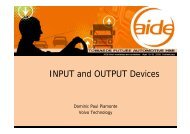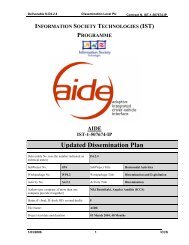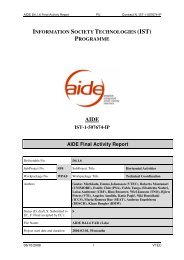download deliverable - AIDE
download deliverable - AIDE
download deliverable - AIDE
Create successful ePaper yourself
Turn your PDF publications into a flip-book with our unique Google optimized e-Paper software.
Deliverable D4.2.1 Dissemination Level PU Contract N. IST-1-507674-IP<br />
• Driver impairment (fatigue).<br />
Finally, for the scenario description three different conflict situations were considered:<br />
• Conflict between concurrent actions;<br />
• Conflict between one action and DVE conditions;<br />
• Conflict between multiple actions and DVE conditions.<br />
In order to get a better impression of the scenario description, one exemplary is given in the<br />
following:<br />
<strong>AIDE</strong> design scenario 1.6: Conflict between two output messages<br />
Action/s = {OP i , OP j }, where<br />
i=1...3<br />
OP 1 = Mandatory messages or important info related to the instant driving task<br />
OP 2 = Temporary info related to the driving task, requiring an action in the near future<br />
OP 3 = Permanent status-info related to the driving task, not requiring an action in the near future<br />
OR output messages related to the secondary task<br />
DVE Condition/s: DVE 1-5 =LOW/NO<br />
Flow of events 1<br />
1. OP i is executed<br />
2. OP j is initiated<br />
Possible <strong>AIDE</strong> solution(s)<br />
1. OP i and OP j are presented in different modalities.<br />
2. OP j is delayed until OP i has finished<br />
Example:<br />
Conflict scenario: A route guidance message is given. While the message is executed, an<br />
incoming phone call is initiated.<br />
Possible solution: The phone call is delayed until the route guidance message has finished.<br />
Table 1 <strong>AIDE</strong> Design scenarios – Conflict between two output messages.<br />
This description format is unique today and offers the possibility to handle the integrated<br />
in-vehicle HMI taking into account the different HMI strategies of the OEM's.<br />
The categorizations which lead to a generalized description of the functional extent of the<br />
system form a suitable basis for further system architecture development and fulfil the most<br />
important requirements with respect to scalability and flexibility. That is a crucial condition<br />
for an introduction of <strong>AIDE</strong> functionality in future vehicles.<br />
3.3. Evaluation of Adaptive Integrated HMIs<br />
Presenter: Klauss Bengler, BMW.<br />
BMW as a member of <strong>AIDE</strong> project and a representative of one of the major automotive<br />
industries communicated the current state of the art on the integration fields and described the<br />
adaptation approaches adopted from several up-to-date European and United States funded<br />
projects.<br />
Integration need occurred when several separate systems including in-vehicle<br />
entertainment and safety systems were installed in the car. Today more and more IVIS (invehicle<br />
information systems) and ADAS (adaptive driver assistance systems) applications are<br />
integrated in vehicles which individually interact with the driver and sometimes even<br />
dedicated I/O devices are used. The need for the development of a homogenous driver support<br />
system which integrates different ADAS and IVIS functions emerges imperatively.<br />
25/07/2005 14 ICCS







